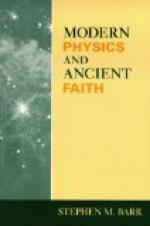“The drop of water but for local causes, but for a certain attraction of the earth, would float in the centre of the jar at the centre of gravity, as the earth does in space. But the centre of gravity of the two bodies is far within the earth, and the drop gets as close to it as it can. The earth’s ‘pull’ takes it to the bottom. If the jar were far enough away in space the drop would float, as the earth floats, at a point where all pulls balance, and the drop of water would have enough pull of its own, enough gravity within itself to hold all the gas left in the jar to itself as an atmosphere. It would be a centre of energy, a minature world.
“The drop of water is not a homogenous mass. About one third of the bulk of the drop of water is made up of independent oxygen and hydrogen atoms interspersed through it, as any liquid is through this piece of blotting paper. And it has, and keeps, by its own attraction, an atmosphere of the gas. Each molecule of water has a thin layer, or skin, of the gas; even as it comes from this faucet.
“Let us return again to the physical dust, the atom. Why should it form by fives for iron, by nines for hydrogen? Where did the atom come from? What is it? We know that like the drop of water, it is a miniature world with an atmosphere of ether; and the natural inference is that it is made from ether as the drop of water was made from gas. Many things confirm this inference, and it may be accepted as ‘a working hypothesis’ that it is made from ether as the drop of water is made from gas, by the chemical union of a large amount of ether of different kinds, the etheric molecules of which consist of 2 and 3 or 5 and 4 etheric atoms, and that the tendency to combine in this or that number in physical matter is an inherited tendency brought with it from the etheric world of matter on which, or in which, each element of this world is two or more. There is no kind of matter in this physical world, that has not its prototype in the etheric, and the laws of its action and reaction here are laws which it inherits and brings with it. They are not laws made here. They are laws of the other world—even as the matter itself is matter of the other world.
“In 1882, Professor Lodge, in a lecture before the Royal Institution on ‘The Luminiferous Ether’ defined it as:
“’One continuous substance, filling all space, which can vibrate as light, which can be sheared into positive and negative electricity, which in whirls constitutes matter, and which transmits by continuity and not impact every action and reaction of which matter is capable.’
“This reads today like baby-talk but at that time (eighteen years ago), it was considered by many timid conservative scientists as ‘a daring movement.’ It is noteworthy in that it was the first public scientific announcement that the physical matter is a manifestation or form of the ether. And it was made before general acceptance of the division of the ether into soniferous, luminiferous and tangiferous.




